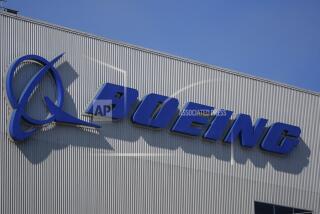Boeing to shut C-17 plant in Long Beach
Aerospace giant Boeing Co. announced plans to close its sprawling Long Beach plant and eliminate thousands of assembly-line jobs where the hulking C-17 cargo plane is built.
The plant is one of the last vestiges of an era in which aviation and aerospace helped build Southern California’s middle class, and it was a major employer in Long Beach for decades.
The announcement Wednesday came just a week after Boeing delivered its 223rd and final C-17 to the Air Force. It has a few foreign orders to fill, but company officials have decided to shut down the assembly line for good in 2015.
Although the plant had been considered in danger of closing in recent years, many workers had hoped that it would remain in operation. The news Wednesday shook longtime workers.
“It’s like a mortuary in there,” said Vince Breen, 58, a structural mechanic, after getting off his shift. “We were stunned.”
Boeing said nearly 3,000 employees support the C-17 production program in Long Beach; Macon, Ga.; Mesa, Ariz.; and St. Louis. The company plans the workforce reductions beginning in early 2014 and continuing through closure.
There are no plans to move a new production program into the 1.1-million-square-foot facility. Boeing said some workers may be moved to other jobs inside the company, but many will have to enter an already tough job market, in which unemployment now stands at 9.9% in Los Angeles County.
“Ending C-17 production was a very difficult but necessary decision,” said Dennis Muilenburg, chief executive of Boeing’s defense, space and security sector. “We want to thank the highly skilled and talented employees who have built this great airlifter for more than two decades.”
Sung Won Sohn, a nationally known economist at Cal State Channel Islands, said the Southland aerospace industry has been in decline for years.
“The impact will be painful and long-lasting in the communities which are affected,” he said. “Aerospace has created a lot of high-paying jobs and other related jobs in Southern California, everything from housing to restaurant sales.”
Aircraft manufacturing first boomed in California during World War II, with factories churning out war birds around the clock. At its peak during World War II, the Douglas Aircraft plant in Long Beach employed 50,000 people and a new plane was completed every two hours. Its prosperity spawned new communities, such as Lakewood, to house workers.
After the war came to a close, the industry evolved during the Cold War. The Air Force awarded the contract for the C-17 in 1981 as the United States faced potential military threats that required massive cargo lifts.
Design work soon followed, and the first C-17 to fly — known as T-1 — took off in 1991. Programs like the C-17 provided well-paying jobs to PhDs fresh out of Caltech and manufacturing workers with a high school degree.
In its heyday, the C-17 plant was fully staffed with a parking lot so big that workers put flags on their cars to find them in the sea of vehicles.
The Long Beach plant was built by Douglas Aircraft Co., and the plant still has a large “Fly DC Jets” sign nearby. It thrived for decades, employing thousands and producing some of the world’s most popular airliners, including the DC-3, DC-8 and MD-80.
In the decades since the Cold War, the aerospace industry went through a major retrenchment that led to consolidation of the industry as competition from overseas grew. In mergers over those years, Douglas became McDonnell Douglas, which later joined with Boeing.
“The plant is a symbol of a past era in Southern California,” said Peter Westwick, author of “Blue Sky Metropolis: The Aerospace Century in Southern California.” “Aerospace manufacturing was the path to the middle class for many Southern Californians.”
Aerospace workers in Los Angeles County fell to just 56,780 last year, according to the county Economic Development Corp., which tracks the industry. That was a nearly 70% drop from the 189,035 workers employed in 1990.
Cost overruns, technical difficulties and repeated delays caused the C-17 to become one of the most controversial defense procurement programs of the 1990s.
But as production got going, the problems were solved and the plane became a workhorse for the military. Today, it has the highest readiness rate of any cargo plane in the U.S. arsenal.
The C-17 Globemaster III is a massive, four-engine jet that can haul 60-ton tanks, troops and medical gear across continents and land on short runways.
The Air Force stopped ordering C-17s in 2006. Since then, Congress added last-minute appropriations for more planes to keep the plant rolling. Again and again, lawmakers came to the program’s rescue, partly because it supports roughly 30,000 supplier jobs in 44 states.
In 2010 lawmakers set aside funding for 10 new planes. That year, then-Defense Secretary Robert M. Gates told Congress he would recommend that President Obama veto legislation that contains money to pay for any additional C-17s.
There have been no new orders from the U.S. since then. Last year, the Air Force granted to Boeing a contract for $500 million calling for transition to “post-production.”
As Air Force orders have dwindled, Boeing has cut jobs at the plant. The Chicago company said it slowed production rates to 10 aircraft a year from 15 to extend the assembly line’s life by several months.
The slower production rates would buy time for Boeing to sell more planes to foreign buyers that came too few and far between.
For several years, the company has been pushing foreign sales to help prolong work there. But because most foreign orders were relatively small they haven’t sustained the plant for more than a few months.
“While not unexpected, today’s announcement closes the chapter on production of a remarkable aircraft,” Long Beach Mayor Bob Foster said. “As work slowed over the last several years, we worked side by side with Boeing to extend the C-17 line for seven additional years. There’s a sense of sadness to see the end of an institution.”
There’s some hope. Boeing, which for years has been cutting its workforce in Southern California, announced that the work performed by 375 people in the Puget Sound region around Seattle is being moved to Long Beach over the next 18 months. In May, the Chicago plane maker said 300 engineering support jobs would come to the region, as well as the establishment of a new engineering design center for commercial aircraft.
As workers filed out of the building after the 2:30 p.m. shift change Wednesday, some looked upset, shaking their heads, while others smiled and told reporters everything was all right.
Tooling engineer Ken Hubbard, who worked for 27 years at the plant, said he will be touching up his resume.
“For starters it’s a wonder it lasted as long as it did,” he said. “Nothing lasts forever.”
Times staff writer Shan Li contributed to this report.
More to Read
Inside the business of entertainment
The Wide Shot brings you news, analysis and insights on everything from streaming wars to production — and what it all means for the future.
You may occasionally receive promotional content from the Los Angeles Times.












